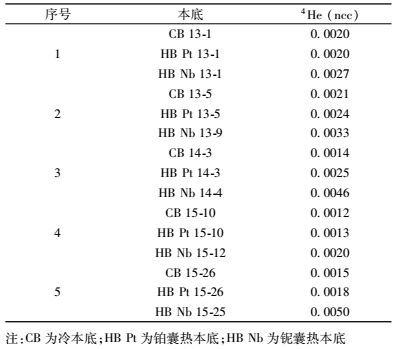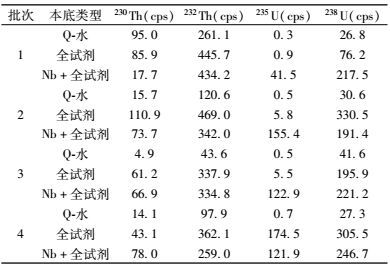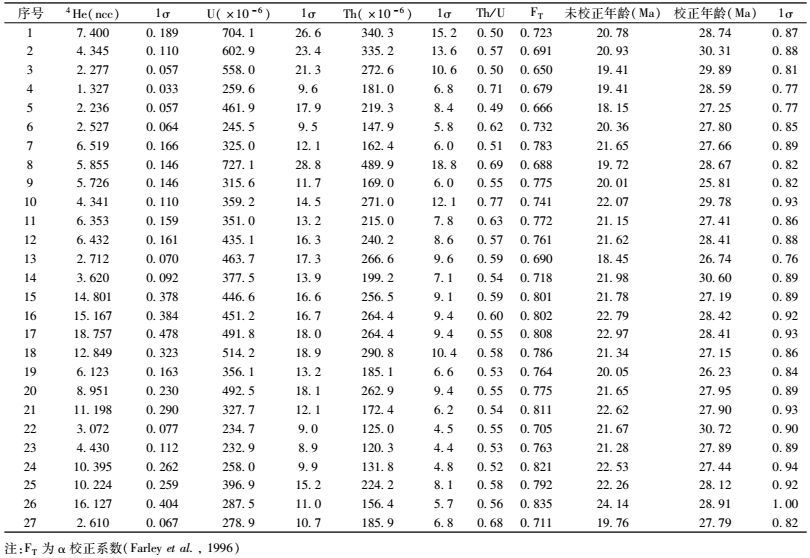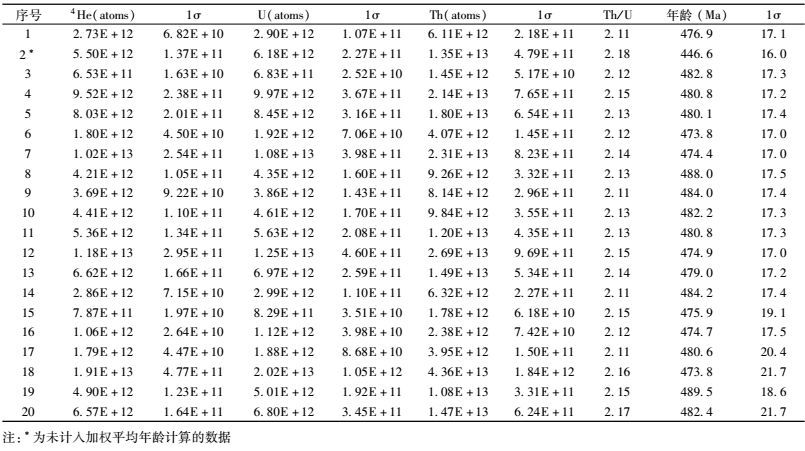(U-Th)/He同位素定年是以U、Th为母体元素,4He为放射性子体元素的一种放射性同位素定年方法。该方法早在二十世纪初就被提出来(Strutt, 1905, 1908) 。但由于在随后的应用中得到过于年轻的年龄(Damon, 1957; Fanale and Kulp, 1962; Ferreira et al., 1975; Leventhal, 1975),一直被认为不适合进行地质体定年,使得该方法长时间被搁置。直到1987年,Zeitler et al. (1987) 通过进行磷灰石的4He扩散实验发现磷灰石的(U-Th)/He定年体系的封闭温度为105±30℃,认为其可以作为与裂变径迹类似的热年代学定年方法。后续的4He扩散实验及地质应用研究(Farley, 2000; Lippolt et al., 1994; Warnock et al., 1997; Wolf et al., 1996) 进一步推动了磷灰石(U-Th)/He定年方法在地质应用领域的发展。基于4He扩散实验在磷灰石(U-Th)/He定年方法上的成功应用,研究者相继开发了其他含U和Th元素的矿物的(U-Th)/He定年方法,如榍石(Reiners and Farley, 1999, 2001; House et al., 2000) 、赤铁矿(Lippolt et al., 1993; Wernicke and Lippolt, 1994)等。
基于He扩散理论的应用以及磷灰石和榍石等矿物(U-Th)/He定年方法的成功建立,研究者将(U-Th)/He定年方法应用到U、Th含量更高的单矿物上——锆石(Reiners et al., 2002, 2004; Tagami et al., 2003) 。在关注锆石的成分分带、辐射损伤等因素对其(U-Th)/He年龄影响的同时,进行了实验方法的探索和升级。He气提取的方式从真空加热炉加热(Tagami et al., 2003) 发展为激光加热(Reiners et al., 2004),从而降低了实验本底,并提高了实验效率;样品量的选取和实验处理方式在单颗粒化学全溶的基础上开始探索微区激光剥蚀(Boyce et al., 2006, 2009; Evans et al., 2015; Horne et al., 2016) 。我国科学家在国际上(U-Th)/He实验方法建立之初就已经开展了相关的应用研究(Zhou et al., 2002),并在近几年的应用研究中快速发展(Li et al., 2014; Qiu et al., 2012; Tian et al., 2013; Wu et al., 2016; Yu et al., 2014; 孙敬博等, 2015; 张斌等, 2016),但国内的(U-Th)/He定年实验方法起步相对较晚。中国地质科学院地质研究所于2010年成功建立磷灰石(U-Th)/He定年实验方法(张彦和陈文, 2011),近几年国内多家实验室引进了氦含量分析的同位素质谱仪,陆续开始(U-Th)/He定年实验方法的研发。但对于锆石(U-Th)/He定年实验方法的开发,目前鲜有数据报道。本实验室已成功开发单颗粒锆石(U-Th)/He定年实验方法,并对国际上普遍使用的FCT和斯里兰卡锆石(U-Th)/He定年标准样品进行了测试,均获得了与参考值一致的结果。本文将详细介绍同位素稀释法进行单颗粒锆石(U-Th)/He定年的实验方法及对国际标准样品的测试情况。
2 定年原理(U-Th)/He法测年技术的原理是根据矿物中母体同位素衰变产生子体同位素4He发展而来的。地壳中的4He主要是放射性成因的4He,是由238U、235U、232Th和147Sm的一系列放射性衰变产生的。由于147Sm产生的4He远远低于其他三种同位素,因此计算中通常不予考虑。U、Th同位素的衰变方程具体如下:
238U (α衰变)→206Pb+84He+6β-
235U (α衰变)→207Pb+74He+4β-
232Th (α衰变)→208Pb+64He+4β-
根据以上衰变方程,得到4He年龄的基本方程为:

|
(1) |
其中4He、238U、235U、232Th为t时刻同位素的原子数,λ238、λ235、λ232分别是238U、235U、232Th的衰变常数, 其值分别为1.55125×10-10/a、9.8485×10-10/a、4.9475×10-11/a。
衰变过程中产生的α粒子(4He)具有4~8MeV的初始动能,使得α粒子在形成后能够在晶体内部运移一段距离后才停止,这个距离称为α停止距离(α-stopping distance, Farley et al., 1996) 。α停止距离的长短与α粒子的初始动能、所在晶体的成分和密度有关。238U、232Th、235U产生的α粒子的初始动能依次升高,其相应的α停止距离也依次更长。在特定初始动能的情况下,停止距离与晶体的密度关系更为密切。由于锆石的密度(4.6g/cm3)比磷灰石的密度(3.2g/cm3)大,因此前者的停止距离比后者的小。
位于矿物晶体边缘的U、Th元素衰变产生的α粒子运动方向是随机的,一部分会射到晶体外,靠近晶体表面的母体元素产生的α粒子会有50%的概率出射丢失。这一现象的存在与同位素衰变体系是否封闭无关,因此将造成子体同位素偏低。同理,如果晶体外围存在含U、Th浓度较高的物质,则会有α粒子被植入到晶体中,从而对(U-Th)/He年龄有着显著影响(Gautheron et al., 2012; Murray et al., 2014; Spiegel et al., 2009),但多数情况下,锆石或磷灰石等矿物所含的U、Th远高于周围介质,α植入效应可以不予考虑。由于α出射效应存在会导致(U-Th)/He年龄偏低,因此需要采取相应的措施对偏差进行纠正或消除。一种方式是采用化学或机械手段去除晶体最外层20μm的部分,但大部分主要是对宝石级样品进行处理,如斯里兰卡锆石和Durango磷灰石等。另一种方式是对年龄进行FT校正。Farley et al. (1996) 提出了与晶体体表比、α停止距离、Th/U比值等参数有关的FT校正系数。(U-Th)/He年龄的校正公式为:T校正年龄=T实测年龄/FT。因此,在实验过程中,需要对晶体的尺寸进行测量,以便进行体积和表面积等与FT有关参数的计算。另外,FT校正是基于晶体内U、Th分布均匀的前提,若晶体U、Th分带显著,进行常规FT校正得到的年龄会偏离真实年龄,根据U、Th分带程度的不同,校正年龄可能有高达达30%的偏差(Hourigan et al., 2005),因此,随着对(U-Th)/He定年精度要求的增加,U、Th分带这一因素在特定情况下需要关注。
3 实验流程单颗粒锆石(U-Th)/He定年实验包含三个主要的过程:样品前处理、He含量分析和U、Th含量分析。
3.1 样品前处理岩石样品经过破碎、过筛、淘洗、重液分离等标准的矿物分选流程后,得到锆石矿物颗粒。用于(U-Th)/He定年的锆石样品需要在显微镜下进一步挑选,以满足实验对锆石晶体尺寸、自形程度、包裹体情况等方面的要求。由于α粒子(即4He)射出效应的存在,需要对实测年龄进行校正,尺寸小于60μm的样品因校正系数过大,会严重影响最终年龄的精密度(Farley et al., 1996) ;而尺寸过大的样品(如300μm)可能需要多次加热提取He气,并且大颗粒的晶体在溶解过程中偶尔会出现无法完全溶解的问题等(Reiners, 2005),因此通常选取宽度约70~150μm的晶体进行分析。另外,完整的晶体对于获取准确的年龄也是必不可少的。研究表明,因后期外部因素导致椎体缺失的晶体多数情况下会得到偏老的年龄(Brown et al., 2013),并且在反演热历史过程中可能会得到错误的结果(Beucher et al., 2013) 。锆石中的包裹体可能会造成晶体内部成分的分带效应,因此最佳选择是避免挑选有包裹体的颗粒(Reiners, 2005),由于锆石中的包裹体或内部的子晶在溶样过程中会一同被溶解,因此选择含少量包裹体的锆石是可以接受的。
将挑选好的晶体用数码相机进行拍照,并用测量软件测量晶体的长、宽、高及锥体的长度。得到的测量数据结合晶体的几何形状计算表面积和体积并求出二者的比值;根据不同同位素(238U、235U、232Th)衰变产生的α粒子在锆石晶体内部运移距离和U、Th分析得到的Th/U值等参数计算α校正系数(FT)(Farley, 2002) 。最终得到的经过校正的锆石(U-Th)/He年龄为:校正年龄=实测年龄/FT。
完成拍照和测量后,样品装入长度和直径约为1mm的铌囊中,以防止加热提取He气时U、Th元素蒸发(House et al., 2000) 以及加热取气后在转移过程中可能发生颗粒碎片的丢失(Reiners, 2005) 。
3.2 He含量分析3.2.1 He气提取He气提取和分析在氦同位素质谱仪上进行。该仪器采用970nm二极管激光器(Diode Laser)加热提取He气。对锆石进行加热取气时,激光电流在15A (温度约为1300℃)条件下持续10min。对于同一粒锆石,在相同的流程下至少进行两次取气、分析过程,第二次取气目的为检验第一次取气是否彻底,当第二次气量小于第一次气量1%或接近热本底时,认为取气较为充分;当第二次气量大于第一次气量1%时,进行第三次取气。通常情况下,注意尽量避免更多次的取气,以防止锆石受热时间过长导致U、Th元素蒸发。
3.2.2 He气净化采用氦同位素四极质谱仪配置的净化系统进行净化,该系统包括机械泵、涡轮分子泵、离子泵、锆-铝吸气泵,真空管线和真空测量系统组成,能够对样品释放的4He进行自动化纯化,在装载样品后(激光室暴露大气),真空抽气系统经过机械泵3min抽气和涡轮分子泵12h抽气之后,系统内真空度低于1.0×10-8Torr,该真空度可满足实验要求。样品释放出的4He与稀释剂3He混合,经过锆-铝泵净化60秒,可以有效去除活性气体(如H2O、N2、SO2、O2、CO2等),净化之后的气体即可进入质谱仪进行分析。分析持续约为150s,分析结束后,分析室内的气体被分子泵抽走,然后与离子泵连通进一步净化。
3.2.3 He气质谱分析本实验采用同位素稀释法进行4He含量测定。在4He分析测试过程中,首先测定从4He标准气体罐中放出的已知量4He标准气体(4HeQstandard)与一定体积的spike气体(3HeSpike)混合后的比值((4He/3He)Spiked Qstandard):
4HeQstandard=3HeSpike (4He/3He)Spiked Qstandard
然后测定样品释放的4He气体与spike气体(3HeSpike)混合后的比值:
4HeSample=3HeSpike (4He/3He)Spiked Sample
联立上面两个式子可得到样品所释放的4He的量:
4HeSample=4HeQstandard×[(4He/3He)Spiked Sample/
(4He/3He)Spiked Qstandard]
通过稀有气体质谱仪测得(4He/3He)Spiked Qstandard和(4He/3He)Spiked Sample。质谱仪测得的样品的4He、3He同位素二者的比值相对标准偏差约0.1%。本实验在基于两次测试释放的spike气体(3HeSpike)体积近似相等的前提下,样品中的4He量通过已知量4He标准气体(4HeQstandard)计算得到。
已知量4He标准气体(4HeQstandard)是由标准4He气罐(Tank)平衡扩散到标准小管(Pipette)中的气体。标准4He气罐体积约为3300cc,标准小管体积约为0.3cc。气罐与标准小管连通,待二者气压平衡后,标准4He气罐中的气体总量将有所减少,其每次释放后所减少的比例是固定的,为VTank/(VTank+VPipette),该比值即为消耗因子(Depletion Factor, 缩写为DF),所以经标准小管第N次释放出的4He的量为QN=Qcal×DF(N-cal),其中Qcal为仪器出厂时已校准的经标准小管释放的4He的量,(N-cal)为出厂后释放过4He的次数。关于如何确定标准4He气罐和标准小管体积的基本原理可参阅(张彦和陈文, 2011) 。
3.3 U、Th含量分析3.3.1 U、Th含量分析理论基础本实验采用同位素稀释法进行U、Th含量测定。样品中235U和230Th的含量通过两个步骤得到:a)含较高浓度235U和230Th的稀释剂中238U和232Th的确切含量通过与已知浓度的标准试剂进行同位素稀释获得;b)样品中238U和232Th的确切含量通过步骤a得到确切浓度的稀释剂进行同位素稀释获得。
a)将稀释剂与标准试剂混合,计算稀释剂中238U和232Th的确切含量
稀释剂中238U的含量:

|
(①) |
公式①中,238UK为从已标定的标准试剂中加入到混合溶液中的确切的238U的分子数;(235U/238U)Spike为稀释剂中已标定的235U/238U的比值;(235U/238U)K为标准试剂中已标定的235U/238U的比值;(235U/238U)Mix为实验室测得的稀释剂与标准试剂混合溶液中235U/238U的比值。
稀释剂中232Th的含量:

|
(②) |
与公式①类似,232ThK为从已标定的标准试剂中加入到混合溶液中的确切的232Th的分子数;(230Th/232Th)Spike为稀释剂中已标定的230Th/232Th的比值;(230Th/232Th)Mix为实验室测得的稀释剂与标准试剂混合溶液中230Th/232Th的比值;标准试剂中230Th/232Th值为0。
b)将稀释剂与样品溶液混合,计算样品中238U和232Th的确切含量
样品中238U的含量:

|
(③) |
公式③中,238USpike为通过步骤a中计算得到的从稀释剂中加入到混合溶液中的确切的238U的分子数;(235U/238U)Spike为稀释剂中已标定的235U/238U的比值;(235U/238U)Sample为样品中天然的235U/238U的比值;(235U/238U)Mix为实验室测得的稀释剂与未知样品溶液的混合溶液中235U/238U的比值。
样品中232Th的含量:

|
(④) |
公式④中,232ThSpike为步骤a中计算得到的从稀释剂中加入到混合溶液中的确切的232Th的分子数;(230Th/232Th)Spike为稀释剂中已标定的230Th/232Th的比值;(230Th/232Th)Mix为实验室测得的稀释剂与标准试剂混合溶液中230Th/232Th的比值;样品中230Th/232Th值为0。
3.3.2 锆石化学溶解锆石的化学溶解需要在高压釜(Parr)中经历多次消解。待溶解的样品和用于全流程本底检验的空铌囊放在4.5mL容积的特氟龙溶样瓶中,第一次消解时样品中加入25μL稀释剂溶液,该稀释剂溶液基质为50%体积浓度的硝酸溶液,235U和230Th浓度分别为15×10-9和5×10-9,另外加入350μL浓HF;标准溶液中加入等体积同种稀释剂并加入25μL含25×10-9 U和25×10-9 Th的标准试剂;空铌囊只加入相应的酸作为空白值测试。在高压釜的内胆中加入420μL浓硝酸和9mL浓HF。内胆装入高压釜中并密封,放入恒温干燥箱中240℃条件下加热40h。降至室温之后,已消解的溶液在电热板上加热蒸干。蒸干之后进行第二次消解,每个溶样瓶中加入300μL浓盐酸,高压釜的内胆中加入9mL浓盐酸。密封好的高压釜在240℃的条件下加热24h。消解之后,将溶液蒸发部分酸液后再加入超纯水稀释之后即可进行U、Th分析。
3.3.3 U、Th含量仪器测试U、Th分析在电感耦合等离子质谱(ICP-MS)上进行。采用低流速雾化器。主要测试质量数为230、232、235、238的同位素的计数(cps)。样品溶液中的同位素计数扣除本底后计算230/232和235/238的比值。在ICP-MS稳定工作状态下,测得样品的U、Th同位素含量相对标准偏差通常小于1%。
最后,将测得的4He,238U,232Th代入公式(1) 中计算得到(U-Th)/He年龄。
4 测试结果与讨论4.1 4He本底每批样品4He测试之前均进行冷本底和热本底测试。冷本底为不进行激光加热情况下测试实验过程中涉及到的管路中4He的含量;热本底采用正常的样品测试流程对空铌囊或铂囊进行激光加热并测试获得4He含量。长期多批次的本底测试结果(表 1) 显示,冷本底和铂囊热本底基本一致,始终维持在0.0012~0.0025ncc左右;铌囊的热本底稍高,约为0.0020~0.0050ncc。锆石和磷灰石单颗粒样品的He含量绝大多数情况下均在本底水平102~103倍以上,对样品4He含量测试几无影响。
|
|
表 1 4He本底分析结果 Table 1 Measurement results of 4He blanks |
为了测试全流程空白并监控试剂、铌囊是否被污染以及容器是否清洗干净,每批样品进行化学溶解时,均进行试剂和空铌囊的空白检测,每项本底检测数量约为3~5个。每个试剂和空铌囊的空白检测均加入溶样过程中所用的试剂,包括水、硝酸溶液、氢氟酸和盐酸等。由于在空白检测过程中不加入稀释剂,因此无法定量获知本底中U、Th元素的含量,但可以获取等离子质谱测得的U、Th同位素的信号量(cps),根据信号量的高低可评估本底水平。在进行样品U、Th含量计算时,将实测样品溶液中U、Th同位素的信号量扣除本底相应同位素的信号量。表 2为纯水、纯化的试剂及完整实验流程的本底水平。通常情况下,加入稀释剂的样品溶解后的U、Th同位素的信号量约为几十万cps,因此在此本底水平下,对样品年龄结果几无影响。
|
|
表 2 U、Th本底测试结果 Table 2 Measurement results of U, Th blanks |
Fish Canyon Tuff锆石(简写FCT)是从位于美国科罗拉多州南部圣吉安地区中央的塔格利塔破火山口喷出的。在其玻璃质的基质中含有大量可定年的斑晶,包括斜长石、透长石、黑云母、角闪石、磷灰石、锆石等。其中的黑云母、透长石等被国际上多个实验室作为Ar-Ar定年的标准物质,其中透长石Ar-Ar年龄为28.03±0.08Ma (Jourdan and Renne, 2007),黑云母Ar-Ar年龄为28.13±0.47Ma (Dazé et al., 2003) 。Schmitz and Bowring (2001) 得到FCT的高精度锆石U-Pb年龄为28.48±0.06Ma (2σ),其他高精度锆石U-Pb定年研究也得到近似的结果(Bachman et al., 2007) 。另外,其中的磷灰石和锆石也被广泛用来作为裂变径迹定年的标准物质(Carpéna and Mailhé, 1987; Cebula et al., 1986; Naeser et al., 1981) 。近年来,国际上多家(U-Th)/He实验室将FCT锆石用来作为实验室内部的(U-Th)/He定年标准物质,得到较为一致的加权平均年龄,分别为28.6±1.4Ma (1σ)(Tagami et al., 2003) 、27.3±2.1Ma (2σ)(Reiners et al., 2002) 、28.3±2.6Ma (2σ)(Reiners et al., 2005) 、28.29±0.26Ma (Reiners and Nicolescu, 2006)和28.3±0.4Ma (Gleadow et al., 2015) 。为检验本实验室的实验流程是否可靠,进行了多批次共计27粒FCT锆石的(U-Th)/He年龄测定(表 3) 。图 1为27颗锆石的年龄分布范围和年龄概率分布情况,年龄范围为25.81~30.72Ma,其加权平均年龄为28.18±0.51Ma (1σ)。图 2为本实验室与国际上多个实验室发表的锆石(U-Th)/He年龄及Th/U测试数据对比,表明了锆石(U-Th)/He年龄和Th/U比值均与国际多个实验室测试结果一致。
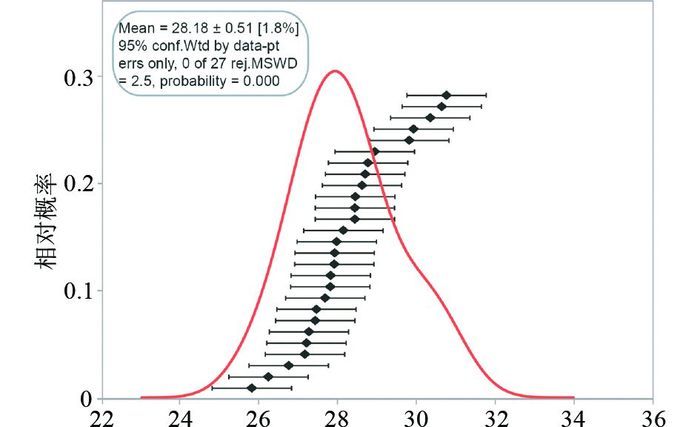
|
图 1 FCT锆石(U-Th)/He年龄及概率分布图 Fig. 1 Probability density and individual crystal (U-Th)/He ages of FCT zircons |
|
|
表 3 FCT锆石(U-Th)/He年龄 Table 3 (U-Th)/He data of FCT zircons |
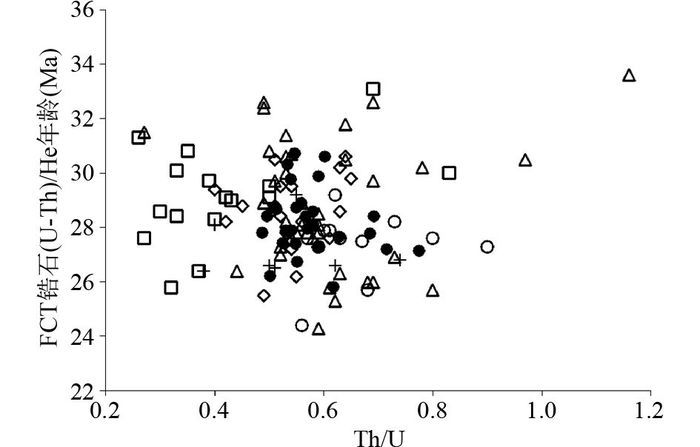
|
图 2 不同实验室对FCT锆石(U-Th)/He年龄及Th/U比值的测试结果(n=120) Fig. 2 (U-Th)/He ages of FCT zircon plotted against Th/U ratio from different laboratories (n=120) Filled circles-our lab. (n=27) ; open circles-Curtin University (n=12, McInnes et al., 2009) ; open triangles-University of Melbourne (n=39, Gleadow et al., 2015) ; open squares-California Institute of Technology (n=16, Tagami et al., 2003) ; plus sign-Yale University (n=19, Reiners et al., 2005) ; opens rhombus-Washington State University (n=7, Reiners et al., 2002) |
斯里兰卡锆石为采自斯里兰卡高原的宝石级锆石晶体。用于锆石U-Pb定年的国际标准样品很多来自该地区(Nasdala et al., 2004, 2008),近年来也被国外部分实验室用来作为微区锆石(U-Th)/He定年的标准样品(Evans et al., 2015; Vermeesch et al., 2012) 。本文所用斯里兰卡锆石为伦敦大学学院地球科学系实验室开发的锆石(U-Th)/He定年标准样品(Tian et al., 2017),为一颗宝石级的锆石晶体磨掉外层20μm部分后破碎而成(FT=1),该实验室测定的锆石(U-Th)/He参考年龄为470±11Ma。本实验室已测试20粒锆石碎片,年龄范围为446.0~489.5Ma,Th/U比值范围为2.11~2.18,详细测试数据见表 4。进行年龄统计时,剔除一粒异常年轻的年龄,其余19粒样品的加权平均年龄为479.0±8.0Ma (1σ)(图 3),与参考年龄在误差范围内一致。
|
|
表 4 斯里兰卡锆石(U-Th)/He年龄 Table 4 (U-Th)/He data of Sri Lanka zircons |
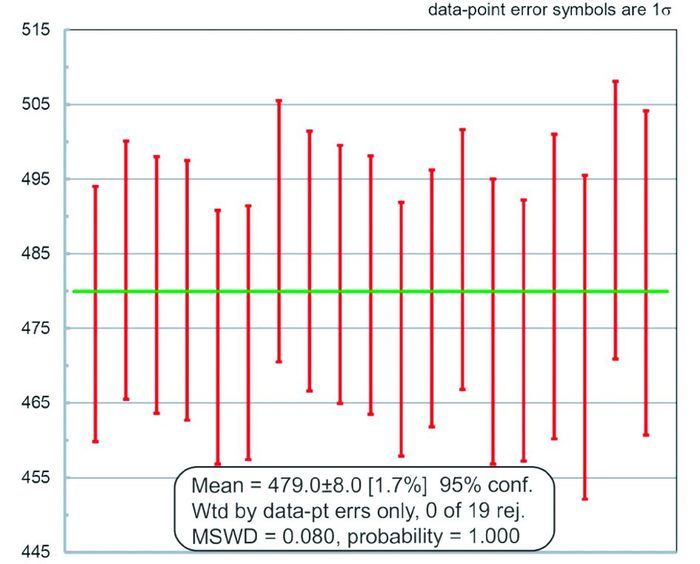
|
图 3 斯里兰卡锆石(U-Th)/He年龄加权平均图 Fig. 3 Weighted average of (U-Th)/He ages for Sri Lanka zircons |
同一样品中不同颗粒之间的(U-Th)/He年龄,往往会存在一定的分散性。即便是国际上普遍使用的(U-Th)/He年龄标准物质FCT锆石,通常也会存在5%以上的标准偏差(Dobson et al., 2008; Reiners et al., 2002, 2005) 。研究表明,通过等效U浓度(eU=U+0.235×Th)所反映的辐射损伤对(U-Th)/He年龄有一定影响(Flowers, 2009; Flowers et al., 2009; Shuster et al., 2006),根据辐射损伤的程度不同和样品所经历热历史的差异,锆石(U-Th)/He年龄与eU可能会存在正相关或负相关的关系(Guenthner et al., 2011, 2013) 。但是如果样品经历极快速的冷却历史,(U-Th)/He年龄与eU二者之间关系通常并不显著(Guenthner et al., 2014) 。对于FCT锆石,eU与(U-Th)/He年龄的确未发现明显的相关性(图 4a)。研究表明当岩石在He半保留区间内停留较长时间(>107年)时,岩石中磷灰石的晶体尺寸对于He年龄会产生显著影响(Reiners and Farley, 2001),对于快速冷却的FCT锆石,通过本文的数据显示其(U-Th)/He年龄与晶体尺寸二者之间的相关性并不显著(图 4b)。由于FCT锆石内部U、Th分带普遍存在,FT校正会造成完整单颗粒晶体之间的(U-Th)/He年龄不一致(Dobson et al., 2008; Fitzgerald et al., 2006; Hourigan et al., 2005; Reiners et al., 2005; Tagami et al., 2003) 。另外,对于同一颗粒内的不同碎片而言,U、Th分带必然会造成晶体不同部位U、Th浓度不同,而衰变产生的α粒子具有一定的动能,在晶体内部运移后,会造成4He与U、Th的分布在空间上无法严格匹配,从而导致同一颗粒的不同碎片之间年龄存在差异。因此,U、Th分带可能是造成包括杜兰戈(Durango)磷灰石(Boyce and Hodges, 2005)和斯里兰卡锆石碎片等样品(U-Th)/He年龄出现小范围内分散的主要原因之一。

|
图 4 FCT锆石(U-Th)/He年龄与eU (a)和等效半径(b)关系图 Fig. 4 (U-Th)/He ages vs. eU (a) and radius (b) for FCT zircons |
对于(U-Th)/He年龄,由于矿物个体的U、Th浓度差异和内部分带、晶体大小和结构差异、包裹体、α校正等因素的存在,使得人们普遍认识到不同晶体之间差异所造成年龄的分散性比分析测试的精密度造成的分散要大的多(Boyce and Hodges, 2005; Reiners and Nicolescu, 2006) 。造成年龄分散的因素还跟样品经历的地质过程有关,使得诸如eU、冷却速率等某些特定的因素成为年龄分散的主因(Guenthner et al., 2011, 2013),甚至会造成(U-Th)/He年龄比封闭温度更高的裂变径迹的年龄还大的现象(Danišík et al., 2008; Green and Duddy, 2006; Shuster et al., 2006) 。因此,在某些特定的地质环境下,要得到准确有效的热演化信息,需要采取特定的校正手段对年龄进行校正,如提前进行U、Th分带检验(Dobson et al., 2008) 、考虑辐射损伤与年龄分散的关系(Guenthner et al., 2014)等。
5 结论锆石(U-Th)/He定年是同位素热年代学体系中重要的定年手段,是记录地质体完整热历史不可或缺的实验方法,在火山岩定年、造山带演化、地貌演化、沉积盆地热演化及限定矿床热液活动时代等应用方面发挥着重要的作用。本实验室成功开发了同位素稀释法测定单颗粒锆石(U-Th)/He年龄的实验方法,并对国际上普遍使用的FCT锆石和斯里兰卡锆石标样进行(U-Th)/He年龄测定。得到FCT锆石(U-Th)/He年龄加权平均值28.18±0.51Ma (1σ),斯里兰卡锆石(U-Th)/He年龄加权平均值479.0±8.0Ma (1σ)。两个标准物质的年龄均与参考值一致,表明本实验室的实验流程准确可靠。本实验方法的建立填补了我国锆石(U-Th)/He定年实验方法的空白。
致谢 感谢澳大利亚科廷大学Noreen Evans、Brent I. A. McInnes、Brad McDonald在(U-Th)/He测年技术上的指导帮助;感谢中国科学院地质与地球物理研究所王非研究员、吴林博士在U、Th元素测试提供的帮助;感谢国家地质实验测试中心屈文俊研究员、李超博士在化学实验中提供的大力支持。| [] | Bachmann O, Oberli F, Dungan MA, Meier M, Mundil R, Fischer H. 2007. 40Ar/39Ar and U-Pb dating of the Fish Canyon magmatic system, San Juan Volcanic field, Colorado: Evidence for an extended crystallization history. Chemical Geology, 236(1-2): 134–166. DOI:10.1016/j.chemgeo.2006.09.005 |
| [] | Beucher R, Brown RW, Roper S, Stuart F, Persano C. 2013. Natural age dispersion arising from the analysis of broken crystals: Part Ⅱ. Practical application to apatite (U-Th)/He thermochronometry. Geochimica et Cosmochimica Acta, 120: 395–416. |
| [] | Boyce JW, Hodges KV. 2005. U and Th zoning in Cerro de Mercado (Durango, Mexico) fluorapatite: Insights regarding the impact of recoil redistribution of radiogenic 4He on (U-Th)/He thermochronology. Chemical Geology, 219(1-4): 261–274. DOI:10.1016/j.chemgeo.2005.02.007 |
| [] | Boyce JW, Hodges KV, Olszewski WJ, Jercinovic MJ, Carpenter BD, Reiners PW. 2006. Laser microprobe (U-Th)/He geochronology. Geochimica et Cosmochimica Acta, 70(12): 3031–3039. DOI:10.1016/j.gca.2006.03.019 |
| [] | Boyce JW, Hodges KV, King D, Crowley JL, Jercinovic M, Chatterjee N, Bowring SA, Searle M. 2009. Improved confidence in (U-Th)/He thermochronology using the laser microprobe: An example from a Pleistocene leucogranite, Nanga Parbat, Pakistan. Geochemistry, Geophysics, Geosystems, 10(9): Q0AA01. |
| [] | Brown RW, Beucher R, Roper S, Persano C, Stuart F, Fitzgerald P. 2013. Natural age dispersion arising from the analysis of broken crystals. Part Ⅰ: Theoretical basis and implications for the apatite (U-Th)/He thermochronometer. Geochimica et Cosmochimica Acta, 122: 478–497. |
| [] | Carpéna J, Mailhé D. 1987. Fission-track dating calibration of the Fish Canyon tuff standard in French reactors. Chemical Geology: Isotope Geoscience, 66(1-2): 53–59. DOI:10.1016/0168-9622(87)90028-5 |
| [] | Cebula GT, Kunk MJ, Mehnert HH, Naeser CW, Obradovich JD, Sutter JF. 1986. The Fish Canyon Tuff: A potential standard for the 40Ar/39Ar and fission track dating methods. Terra Cognita, 6: 139–140. |
| [] | Damon PE. 1957. Determination of radiogenic helium in zircon by stable isotope dilution technique. Eos, Transactions American Geophysical Union, 38(6): 945–953. DOI:10.1029/TR038i006p00945 |
| [] | Danišík M, Sachsenhofer RF, Privalov VA, Panova EA, Frisch W, Spiegel C. 2008. Low-temperature thermal evolution of the Azov Massif (Ukrainian Shield-Ukraine): Implications for interpreting (U-Th)/He and fission track ages from cratons. Tectonophysics, 456(3-4): 171–179. DOI:10.1016/j.tecto.2008.04.022 |
| [] | Dazé A, Lee JKW, Villeneuve M. 2003. An intercalibration study of the Fish Canyon sanidine and biotite 40Ar/39Ar standards and some comments on the age of the Fish Canyon Tuff. Chemical Geology, 199(1-2): 111–127. DOI:10.1016/S0009-2541(03)00079-2 |
| [] | Dobson KJ, Stuart FM, Dempster TJ. 2008. U and Th zonation in Fish Canyon Tuff zircons: Implications for a zircon (U-Th)/He standard. Geochimica et Cosmochimica Acta, 72(19): 4745–4755. DOI:10.1016/j.gca.2008.07.015 |
| [] | Evans NJ, McInnes BIA, McDonald B, Danišík M, Becker T, Vermeesch P, Shelley M, Marillo-Sialer E, Patterson DB. 2015. An in situ technique for (U-Th-Sm)/He and U-Pb double dating. Journal of Analytical Atomic Spectrometry, 30(7): 1636–1645. DOI:10.1039/C5JA00085H |
| [] | Fanale FP, Kulp JL. 1962. The helium method and the age of the Cornwall, Pennsylvania magnetite ore. Economic Geology, 57(5): 735–746. DOI:10.2113/gsecongeo.57.5.735 |
| [] | Farley KA, Wolf RA, Silver LT. 1996. The effects of long alpha-stopping distances on (U-Th)/He ages. Geochimica et Cosmochimica Acta, 60(21): 4223–4229. DOI:10.1016/S0016-7037(96)00193-7 |
| [] | Farley KA. 2000. Helium diffusion from apatite: General behavior as illustrated by Durango fluorapatite. Journal of Geophysical Research: Solid Earth, 105(B2): 2903–2914. DOI:10.1029/1999JB900348 |
| [] | Farley KA. 2002. (U-Th)/He dating: Techniques, calibrations, and applications. Reviews in Mineralogy and Geochemistry, 47(1): 819–844. DOI:10.2138/rmg.2002.47.18 |
| [] | Ferreira MP, Macedo R, Costa V, Reynolds JH. 1975. Rare-gas dating, Ⅱ. Attempted uranium-helium dating of young volcanic rocks from the Madeira Archipelago. Earth and Planetary Science Letters, 25(2): 142–150. |
| [] | Fitzgerald PG, Baldwin SL, Webb LE, O'Sullivan PB. 2006. Interpretation of (U-Th)/He single grain ages from slowly cooled crustal terranes: A case study from the Transantarctic Mountains of southern Victoria land. Chemical Geology, 225(1-2): 91–120. DOI:10.1016/j.chemgeo.2005.09.001 |
| [] | Flowers RM. 2009. Exploiting radiation damage control on apatite (U-Th)/He dates in cratonic regions. Earth and Planetary Science Letters, 277(1-2): 148–155. DOI:10.1016/j.epsl.2008.10.005 |
| [] | Flowers RM, Ketcham RA, Shuster DL, Farley KA. 2009. Apatite (U-Th)/He thermochronometry using a radiation damage accumulation and annealing model. Geochimica et Cosmochimica Acta, 73(8): 2347–2365. DOI:10.1016/j.gca.2009.01.015 |
| [] | Gautheron C, Tassan-Got L, Ketcham RA, Dobson KJ. 2012. Accounting for long alpha-particle stopping distances in (U-Th-Sm)/He geochronology: 3D modeling of diffusion, zoning, implantation, and abrasion. Geochimica et Cosmochimica Acta, 96: 44–56. DOI:10.1016/j.gca.2012.08.016 |
| [] | Gleadow A, Harrison M, Kohn B, Lugo-Zazueta R, Phillips D. 2015. The Fish Canyon Tuff: A new look at an old low-temperature thermochronology standard. Earth and Planetary Science Letters, 424: 95–108. DOI:10.1016/j.epsl.2015.05.003 |
| [] | Green PF, Duddy IR. 2006. Interpretation of apatite (U-Th)/He ages and fission track ages from cratons. Earth and Planetary Science Letters, 244(3-4): 541–547. DOI:10.1016/j.epsl.2006.02.024 |
| [] | Guenthner W, Reiners PW, Ketcham RA and Nasdala L. 2011. Development of a radiation damage and annealing model for the zircon (U-Th)/He Thermochronometer. In: AGU Fall Meeting Abstracts. San Francisco, CA, USA: American Geophysical Union |
| [] | Guenthner WR, Reiners PW, Ketcham RA, Nasdala L, Giester G. 2013. Helium diffusion in natural zircon: Radiation damage, anisotropy, and the interpretation of zircon (U-Th)/He thermochronology. American Journal of Science, 313(3): 145–198. DOI:10.2475/03.2013.01 |
| [] | Guenthner WR, Reiners PW, Tian Y. 2014. Interpreting date-eU correlations in zircon (U-Th)/He datasets: A case study from the Longmen Shan, China. Earth and Planetary Science Letters, 403: 328–339. DOI:10.1016/j.epsl.2014.06.050 |
| [] | Horne AM, van Soest MC, Hodges KV, Tripathy-Lang A, Hourigan JK. 2016. Integrated single crystal laser ablation U/Pb and (U-Th)/He dating of detrital accessory minerals-proof-of-concept studies of titanites and zircons from the Fish Canyon Tuff. Geochimica et Cosmochimica Acta, 178: 106–123. DOI:10.1016/j.gca.2015.11.044 |
| [] | Hourigan JK, Reiners PW, Brandon MT. 2005. U-Th zonation-dependent alpha-ejection in (U-Th)/He chronometry. Geochimica et Cosmochimica Acta, 69(13): 3349–3365. DOI:10.1016/j.gca.2005.01.024 |
| [] | House MA, Farley KA, Stockli D. 2000. Helium chronometry of apatite and titanite using Nd-YAG laser heating. Earth and Planetary Science Letters, 183(3-4): 365–368. DOI:10.1016/S0012-821X(00)00286-7 |
| [] | Jourdan F, Renne P R. 2007. Age calibration of the Fish Canyon sanidine 40Ar/39Ar dating standard using primary K-Ar standards. Geochimica et Cosmochimica Acta, 71(2): 387–402. DOI:10.1016/j.gca.2006.09.002 |
| [] | Leventhal JS. 1975. An evaluation of the uranium-thorium-helium method for dating young basalts. Journal of Geophysical Research, 80(14): 1911–1914. DOI:10.1029/JB080i014p01911 |
| [] | Li GM, Cao MJ, Qin KZ, Evans NJ, McInnes BIA, Liu YS. 2014. Thermal-tectonic history of the Baogutu porphyry Cu deposit, West Junggar as constrained from zircon U-Pb, biotite Ar/Ar and zircon/apatite (U-Th)/He dating. Journal of Asian Earth Sciences, 79: 741–758. DOI:10.1016/j.jseaes.2013.05.026 |
| [] | Lippolt HJ, Wernicke RS, Boschmann W. 1993. 4He diffusion in specular hematite. Physics and Chemistry of Minerals, 20(6): 415–418. |
| [] | Lippolt HJ, Leitz M, Wernicke RS, Hagedorn B. 1994. (Uranium+thorium)/helium dating of apatite: Experience with samples from different geochemical environments. Chemical Geology, 112(1-2): 179–191. DOI:10.1016/0009-2541(94)90113-9 |
| [] | McInnes BIA, Evans NJ, McDonald BJ, Kinny PD, Jakimowicz J. 2009. Zircon U-Th-Pb-He double dating of the Merlin kimberlite field, Northern Territory, Australia. Lithos, 112(S1): 592–599. |
| [] | Murray KE, Orme DA, Reiners PW. 2014. Effects of U-Th-rich grain boundary phases on apatite helium ages. Chemical Geology, 390: 135–151. DOI:10.1016/j.chemgeo.2014.09.023 |
| [] | Naeser CW, Zimmermann RA, Cebula GT. 1981. Fission-track dating of apatite and zircon: An interlaboratory comparison. Nuclear Tracks, 5(1-2): 65–72. DOI:10.1016/0191-278X(81)90027-5 |
| [] | Nasdala L, Reiners PW, Garver JI, Kennedy AK, Stern RA, Balan E, Wirth R. 2004. Incomplete retention of radiation damage in zircon from Sri Lanka. American Mineralogist, 89(1): 219–231. DOI:10.2138/am-2004-0126 |
| [] | Nasdala L, Hofmeister W, Norberg N, Martinson JM, Corfu F, Dörr W, Kamo SL, Kennedy AK, Kronz A, Reiners PW, Frei D, Kosler J, Wan YS, Götze J, Häger T, Kröner A, Valley JW. 2008. Zircon M257: A homogeneous natural reference material for the ion microprobe U-Pb analysis of zircon. Geostandards and Geoanalytical Research, 32(3): 247–265. DOI:10.1111/ggr.2008.32.issue-3 |
| [] | Qiu NS, Chang J, Li JW, Li WZ, Yun L, Li HL. 2012. New evidence on the Neogene uplift of South Tianshan: Constraints from the (U-Th)/He and AFT ages of borehole samples of the Tarim basin and implications for hydrocarbon generation. International Journal of Earth Sciences, 101(6): 1625–1643. DOI:10.1007/s00531-011-0745-0 |
| [] | Reiners PW, Farley KA. 1999. Helium diffusion and (U-Th)/He thermochronometry of titanite. Geochimica et Cosmochimica Acta, 63(22): 3845–3859. DOI:10.1016/S0016-7037(99)00170-2 |
| [] | Reiners PW, Farley KA. 2001. Influence of crystal size on apatite (U-Th)/He thermochronology: An example from the Bighorn Mountains, Wyoming. Earth and Planetary Science Letters, 188(3-4): 413–420. DOI:10.1016/S0012-821X(01)00341-7 |
| [] | Reiners PW, Farley KA, Hickes HJ. 2002. He diffusion and (U-Th)/He thermochronometry of zircon: Initial results from Fish Canyon Tuff and Gold Butte. Tectonophysics, 349(1-4): 297–308. DOI:10.1016/S0040-1951(02)00058-6 |
| [] | Reiners PW, Spell TL, Nicolescu S, Zanetti KA. 2004. Zircon (U-Th)/He thermochronometry: He diffusion and comparisons with 40Ar/39Ar dating. Geochimica et Cosmochimica Acta, 68(8): 1857–1887. DOI:10.1016/j.gca.2003.10.021 |
| [] | Reiners PW. 2005. Zircon (U-Th)/He thermochronometry. Reviews in Mineralogy and Geochemistry, 58(1): 151–179. DOI:10.2138/rmg.2005.58.6 |
| [] | Reiners PW, Campbell IH, Nicolescu S, Allen CM, Hourigan JK, Garver JI, Mattinson JM, Cowan DS. 2005. (U-Th)/(He-Pb) double dating of detrital zircons. American Journal of Science, 305(4): 259–311. DOI:10.2475/ajs.305.4.259 |
| [] | Reiners PW and Nicolescu S. 2006. Measurement of parent nuclides for (U-Th)/He chronometry by solution sector ICP-MS, ARHDL Report 1. Tucson, Arizona: University of Arizona |
| [] | Schmitz MD, Bowring SA. 2001. U-Pb zircon and titanite systematics of the Fish Canyon Tuff: An assessment of high-precision U-Pb geochronology and its application to young volcanic rocks. Geochimica et Cosmochimica Acta, 65(15): 2571–2587. DOI:10.1016/S0016-7037(01)00616-0 |
| [] | Shuster DL, Flowers RM, Farley KA. 2006. The influence of natural radiation damage on helium diffusion kinetics in apatite. Earth and Planetary Science Letters, 249(3-4): 148–161. DOI:10.1016/j.epsl.2006.07.028 |
| [] | Spiegel C, Kohn B, Belton D, Berner Z, Gleadow A. 2009. Apatite (U-Th-Sm)/He thermochronology of rapidly cooled samples: The effect of He implantation. Earth and Planetary Science Letters, 285(1-2): 105–114. DOI:10.1016/j.epsl.2009.05.045 |
| [] | Strutt RJ. 1905. On the radio-active minerals. Proceedings of the Royal Society of London, 76(508): 88–101. DOI:10.1098/rspa.1905.0006 |
| [] | Strutt RJ. 1908. On the accumulation of helium in geological time. Proceedings of the Royal Society of London, 81(547): 272–277. DOI:10.1098/rspa.1908.0079 |
| [] | Sun JB, Sun TF, Chen W, Yu S, Yin JY, Li C, Zhang Y, Liu XY. 2015. Thermo-tectonic evolution history of Hongyuntan area, eastern Tianshan, Xinjiang: Constrained from Ar-Ar and (U-Th)/He dating. Acta Petrologica Sinica, 31(12): 3732–3742. |
| [] | Tagami T, Farley KA, Stockli DF. 2003. (U-Th)-He geochronology of single zircon grains of known Tertiary eruption age. Earth and Planetary Science Letters, 207(1-4): 57–67. DOI:10.1016/S0012-821X(02)01144-5 |
| [] | Tian YT, Kohn BP, Gleadow AJW, Hu SB. 2013. Constructing the Longmen Shan eastern Tibetan Plateau margin: Insights from low-temperature thermochronology. Tectonics, 32(3): 576–592. DOI:10.1002/tect.v32.3 |
| [] | Tian YT, Vermeesch P, Danišík M, Condon DJ, Chen W, Kohn B, Schwanethal J, Rittner M. 2017. LGC-1: A zircon reference material for in-situ (U-Th)/He dating. Chemical Geology, 454: 80–92. DOI:10.1016/j.chemgeo.2017.02.026 |
| [] | Vermeesch P, Sherlock SC, Roberts NMW, Carter A. 2012. A simple method for in-situ U-Th-He dating. Geochimica et Cosmochimica Acta, 79(3): 140–147. |
| [] | Warnock AC, Zeitler PK, Wolf RA, Bergman SC. 1997. An evaluation of low-temperature apatite U-Th/He thermochronometry. Geochimica et Cosmochimica Acta, 61(24): 5371–5377. DOI:10.1016/S0016-7037(97)00302-5 |
| [] | Wernicke RS, Lippolt HJ. 1994. 4He age discordance and release behavior of a double shell botryoidal hematite from the Schwarzwald, Germany. Geochimica et Cosmochimica Acta, 58(1): 421–429. DOI:10.1016/0016-7037(94)90474-X |
| [] | Wolf RA, Farley KA, Silver LT. 1996. Helium diffusion and low-temperature thermochronometry of apatite. Geochimica et Cosmochimica Acta, 60(21): 4231–4240. DOI:10.1016/S0016-7037(96)00192-5 |
| [] | Wu L, Monié P, Wang F, Lin W, Ji WB, Bonno M, Münch P, Wang QC. 2016. Cenozoic exhumation history of Sulu terrane: Implications from (U-Th)/He thermochrology. Tectonophysics, 672-673: 1–15. DOI:10.1016/j.tecto.2016.01.035 |
| [] | Yu S, Chen W, Evans NJ, McInnes BIA, Yin J, Sun JB, Li J, Zhang B. 2014. Cenozoic uplift, exhumation and deformation in the North Kuqa Depression, China as constrained by (U-Th)/He thermochronometry. Tectonophysics, 630: 166–182. DOI:10.1016/j.tecto.2014.05.021 |
| [] | Zeitler PK, Herczeg AL, McDougall I, Honda M. 1987. U-Th-He dating of apatite: A potential thermochronometer. Geochimica et Cosmochimica Acta, 51(10): 2865–2868. DOI:10.1016/0016-7037(87)90164-5 |
| [] | Zhang B, Chen W, Sun JB, Yu S, Yin JY, Li J, Zhang Y, Liu XY, Yang L, Yuan X. 2016. The thermal history and uplift process of the Ouxidaban pluton in the South Tianshan orogen: Evidence from Ar-Ar and (U-Th)/He. Science China (Earth Sciences), 59(2): 349–361. DOI:10.1007/s11430-015-5218-z |
| [] | Zhang Y, Chen W. 2011. Study on the 4He content measurement. Geological Review, 57(2): 300–304. |
| [] | Zhou ZY, Reiners PW, Xu CH, Liao ZT, Yang FL. 2002. Zircon (U-Th)/He thermochronological constraints on Cretaceous thermal extension of Dabieshan orogen. Progress in Natural Science, 12(7): 524–527. |
| [] | 孙敬博, 孙腾飞, 陈文, 喻顺, 尹继元, 李超, 张彦, 刘新宇. 2015. 新疆东天山红云滩地区构造-热演化探讨: 来自Ar-Ar和(U-Th)/He热年代学的约束. 岩石学报, 31(12): 3732–3742. |
| [] | 张斌, 陈文, 孙敬博, 喻顺, 尹继元, 李洁, 张彦, 刘新宇, 杨莉, 袁霞. 2016. 南天山欧西达坂岩体热演化历史与隆升过程分析——来自Ar-Ar和(U-Th)/He热年代学的证据. 中国科学(地球科学), 46(3): 392–405. |
| [] | 张彦, 陈文. 2011. 4He同位素含量测试技术研究. 地质论评, 57(2): 300–304. |
 2017, Vol. 33
2017, Vol. 33



